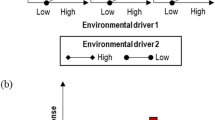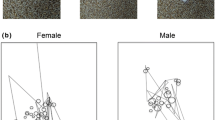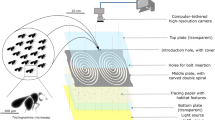Abstract
This article addresses the use of the ecological notion of ‘response diversity’ (Elmqvist et al. Frontiers in Ecology and the Environment, 1(9), 488–494, 2003) to develop a biocentric approach for natural-artificial continuums through the practice of design. The article elaborates upon examples from the project Dispersal machines, part of my postdoctoral research entitled Symbiotic tactics. Dispersal machines proposed two complementary artificial systems that were conceived to minimize the damages by a moth (Spodoptera frugiperda) on crops (corn and soy predominantly) in the agroecosystems of Córdoba, Argentina. The proposals were ideated to biologically control this species by interventions that disseminate and/or host species that predate or parasitize the moth at different stages of its life cycle: a diurnal response, based on the dissemination of parasitized eggs of the moth by a minute wasp (Telenomus remus), as well as a nocturnal response, based on the placement of refuges for bats that feed on the adult moth. Considering these design interventions through the notion of ‘semethic interaction’ (Hoffmeyer 2008) as it relates to the more general term, ‘semiosphere’, the article reflects upon (de)sign as a signifying activity and design’s ‘response-ability’ (Haraway 2016), to speculate upon ways to devise and acknowledge inter-species co-adaptive possibilities.



















Similar content being viewed by others
Notes
Here, I refer to ‘human’ as a simplified category and shorthand without intending to erase the cultural and historical difficulties of this term for this species as acknowledged by a vast literature of decolonial theory. For earlier work in relation to design and decoloniality see Ávila (2017). In the context of biosemiotics see Hendlin (2016), and in relation to the notion of species Kull (2016).
Etymologies consulted throughout this article are based on www.etymonline.com (February 2019).
Throughout this article, the notion of ‘care’ resonates with Maria Puig de la Bellacasa (2017), as a non-normative concept that exposes a relation to some-thing, some-one, that includes overlapping degrees and dimensions of care: labor/work, affect/affections, ethics/politics (2017: 5). In other words: “[…] the double significance of care as an everyday labor of maintenance that conveys ethical obligation: we must take care of things in order to remain responsible for their becomings” (2017: 43).
There are several “others” that could be addressed. In her book The Posthuman, Rosi Braidotti asks: Which other? The sexualized other, woman? The racialized other, the indigenous? The naturalised other, animals, plants, the earth? (see Braidotti 2013: 27, also Hoppe 2019). In this article I am paying attention to a few “naturalised others” for the human instrumental purpose of maintaining human food systems without impoverishing ecological dimensions.
Symbiotic Tactics was financed by the Swedish Research Council (Dnr: 438–2013-297) between 2013 and 2016. The design work developed during this period is a result from collaborations with many professionals and is based on research developed at the Multidisciplinary Institute of Vegetal Biology and other research groups within the Argentinean Research Council (CONICET). My design proposals, some of which are part of this chapter, have been developed together with designer Leonardo López.
Comparing rhythms of the disturbances occasioned by natural and artificial systems, Elmqvist et al. (2003: 489) comment: “Natural disturbances tend to be pulse disturbances with a characteristic magnitude and frequency distribution. Human activities tend to transform pulse disturbances into press or chronic disturbances (Bengtsson et al. 2003) and contribute to the creation of compounded perturbations (Paine et al. 1998). Sustaining desirable states of an ecosystem in the face of compounded perturbations requires that functional groups of species remain available for renewal and reorganization (Lundberg and Moberg 2003). Given the present human simplification of the biosphere and the ensuing loss of species, we cannot take this capacity for renewal and reorganization for granted (Chapin et al. 2000).”
The concept of ‘response diversity’ must be understood in its “overlaps” with the concept of ‘functional diversity’. “Both functional and response diversity are important in the rangeland. Functional diversity increases the performance of the plant community as a whole, bringing together species that take water from different depths, grow at different speeds, store different amounts of carbon and nutrients, and thus complement each other. Response diversity enables the community to keep performing in the same complementary way in the face of stresses and disturbances such as grazing and drought” (Elmqvist et al. 2003: 490).
Daniel Igarzabal is professor of agronomy at Universidad Católica de Córdoba. We also collaborated with Igarzabal for the rearing of moths and parasitoids in the laboratory of his consulting company, Halcón.
Spodoptera frugiperda is an insect belonging to the order Lepidoptera, family Noctuidae of the subfamily Xyleninae. Native of tropical zones, with ample geographic distribution in Argentina, Chile, Brazil, Central and South America, Mexico and the South of the United States. In Argentina it is considered the main pest of the northwest and northeast.
See: http://www.batcon.org/resources/getting-involved/bat-houses and the Bat Conservation Trust http://www.bats.org.uk; also, Alberico et al. (2004); Rueegger (2016).
Collaborating with Lourdes Boero, researcher from the National University of Córdoba who specializes in bats, we captured (with the use of nets at the fields where our intervention was placed), measured, and classified, four different species of bats in one night.
The project was further financed (following the original period 2013–2016 by the Swedish Research Council) as a development project by the Argentinean technology fund, Fontar. Ref: ANR 3500 C3 0152/16. Unfortunately, in spite of having obtained the funding, the money never reached our project, which delayed other applications and thwarted our initiatives and collaborations.
See: www.bats.org.uk.
As noted by Kalevi Kull (2012: 229): “Scaffolding is a reduction of degrees of freedom […] – and this is how scaffolding works, the reason it is useful.”
I am thankful to one of the undisclosed reviewers for pointing this out.
T. remus is a parasitoid that plays an important role in sustaining the diversity of other groups, by regulating populations of arthropods and by controlling dominant competitors. It belongs to the family Scelionidae, sub-family Telenominae. The Scelionidae family comprises only idiobiont endoparasitic insects as it develops completely inside the host egg. Scelionidae have been used successfully in classical biological control programs directed against Hemiptera and Lepidoptera. See Mason et al. (2006); Guarín Campo (2010).
For another similar type of biosemiotic description of multitrophic plant-herbivore-parasitoid-pathogen system see Bruni (2011). Note that the richness of the semiosphere is further used also by hyperparasitoids, attracted to the altered chemical nuances emitted by the plants through parasitized larvae. For a study of the added complexity of biological and ecological inter- and intra-actions of this type of parasitism by volatiles see also Poelman et al. (2012).
When the females of T. remus and T. pretiosum were placed together on the same postures of S. frugiperda, T. remus predominated. See Carneiro 2008.
See Estes et al. 2018. In their analysis, Estes et al. provide indications of how new artefacts and technologies, such as low-cost wireless sensors and autonomous vehicles, are already increasing the spatial and temporal coverage of ecological observations.
References
Alberico, M., Arturo Saavedra, C., & García Paredes, H. (2004). Criterios para el diseño e instalación de casas para murciélagos: Proyecto CPM (Cali, Valle del Cauca, Colombia) – Approaches for the design and installation of houses for bats: Project CPM (Cali, Valle del Cauca, Colombia). Actualidades Biológicas, 26(80), 5–11.
Ávila, M. (2012). Devices. On hospitality, hostility and design. Gothenburg: ArtMonitor.
Ávila, M. (2017). Ecologizing, decolonizing: An artefactual perspective. Nordes, 8, 1–8. Accessed November 18, 2019, from http://www.diva-portal.org/smash/record.jsf?dswid=-8818&pid=diva2%3A1137129&c=2&searchType=SIMPLE&language=en&query=avila&af=%5B%22publicationTypeCode%3AconferencePaper%22%5D&aq=%5B%5B%5D%5D&aq2=%5B%5B%5D%5D&aqe=%5B%5D&noOfRows=50&sortOrder=author_sort_asc&sortOrder2=title_sort_asc&onlyFullText=false&sf=all
Ávila, M. (2019). Three ecologies diffracted. Intersectionality for ecological caring. Nordes, 8, 1–8. Accessed November 18, 2019, from https://archive.nordes.org/index.php/n13/article/view/470/441
Ávila, M., & Ernstson, H. (2019). Realms of exposure: On design, material agency and political ecologies in Córdoba. In H. Ernstson & S. Sörlin (Eds.), Grounding urban natures: Histories and futures of urban ecologies (pp. 137–166). Cambridge: MIT Press.
Barad, K. (2007). Meeting the universe halfway. Quantum physics and the entanglement of matter and meaning. Durham and London: Duke University Press.
Bateson, G. (2000 [1972]). Steps to an ecology of mind. Chicago: University of Chicago Press.
Bird Rose, D., van Dooren, T., & Chrulew, M. (Eds.). (2017). Extinction studies. Stories of time, death, and generations. New York: Columbia University Press.
Braidotti, R. (2013). The Posthuman. Cambridge: Polity Press.
Bruni, L. E. (2011). The multitrophic plant-herbivore-parasitoid-pathogen system: A biosemiotic perspective. In C. Emmeche & K. Kull (Eds.), Towards a semiotic biology (pp. 143–166). London: Imperial College Press.
Carneiro, T.R. (2008). Dinâmica populacional de Spodoptera frugiperda (J. E. Smith) (Lepidoptera: Noctuidae) em milho safra e safrinha e competição entre Telenomus remus Nixon (Hymenoptera: Scelionidae) e Trichogramma pretiosum Riley (Hymenoptera: Trichogrammatidae). Tese Doutor em Agronomia (Entomologia agrícola). Faculdade de Ciências Agrárias e Veterinarias. UNESP: São Paulo, Jaboticabal.
Dunn, R. (2018). Never home alone: From microbes to millipedes, camel crickets, and honeybees, the natural history of where we live. New York: Basic Books.
Elmqvist, T., Folke, C., Nyström, M., Peterson, G., Bengtsson, J., Walker, B., & Norberg, J. (2003). Response diversity, ecosystem change, and resilience. Frontiers in Ecology and the Environment, 1(9), 488–494.
Estes, L., Elsen, P., Treuer, T., Ahmed, L., Caylor, K., Chang, J., Choi, J. J., & Ellis, E. (2018). The spatial and temporal domains of modern ecology. Nature Ecology and Evolution, 2, 819–826. https://doi.org/10.1038/s41559-018-0524-4.
Gamboa Alurralde, S., & Díaz, M. (2018). Diet of Tadarida brasiliensis (Mammalia: Chiroptera) in northwestern Argentina. Acta Chiropterologica, 20(1), 221–228. https://doi.org/10.3161/15081109ACC2018.20.1.017.
Guarín Campo, A. (2010). Biología y Ecología de Telenomus sp. (Hymenoptera: Scelionidae) Parasitoide de huevos de Opsiphanes cassina Felder. (Lepidoptera: Nymphalidae: Brassolinae). Universidad Nacional de Colombia. Facultad de Agronomía. Maestría en Ciencias Agrarias; Área: Entomología. Bogotá. Accessed September 6, 2019, from http://bdigital.unal.edu.co/2706/1/arnulfoguarincampo.2010.pdf
Haraway, D. J. (2016). Staying with the trouble. Making kin in the Chthulucene. Durham and London: Duke University Press.
Hendlin, Y. H. (2016). Multiplicity and welt. Sign Systems Studies, 44(1/2), 94–110.
Hoffmeyer, J. (2007). Semiotic scaffolding of living systems. In M. Barbieri (Ed.), Introduction to biosemiotics. The new biological synthesis (pp. 149–166). Dordrecht: Springer.
Hoffmeyer, J. (2008). Biosemiotics. An examination into the life of signs and the signs of life. Scranton and London: University of Scranton Press.
Hoppe, K. (2019). Responding as composing: Toward a post-anthropocentric, feminist ethics in the Anthropocene. Distinktion: Journal of Social Theory. https://doi.org/10.1080/1600910X.2019.1618360
Krause, B. (2012). The great animal orchestra. London: Profile books.
Kull, K. (1998). On semiosis, Umwelt and semiosphere. Semiotica, 120(3/4), 299–310.
Kull, K. (2012). Scaffolding. In D. Favareau, P. Cobley, & K. Kull (Eds.), A more developed sign. Interpreting the work of Jesper Hoffmeyer (pp. 227–230). Tartu: Tartu University Press.
Kull, K. (2016). The biosemiotic concept of the species. Biosemiotics, 9, 61–71. https://doi.org/10.1007/s12304-016-9259-2.
Kunz, T., Braun de Torrez, E., Bauer, D., Lobova, T., & Fleming, T. H. (2011). Ecosystem services provided by bats (Vol. 1223, pp. 1–38). Annals of the New York Academy of Sciences. https://doi.org/10.1111/j.1749-6632.2011.06004.x.
Maran, T., & Kull, K. (2014). Ecosemiotics: Main principles and current developments. Geografiska Annaler: Series B, 96(1), 41–50.
Mason, W., Huber, J., & Fernandez, F. (2006). El orden Hymenoptera. In F. Fernandez & M. J. Sharkey (Eds.), Introducción a los Hymenoptera de la Región Neotropical (pp. 1–6). Bogotá: Sociedad Colombiana de Entomología y Universidad Nacional de Colombia.
Poelman, E. H., Bruinsma, M., Zhu, F., Weldegergis, B. T., Boursault, A. E., Jongema, Y., van Loon, J. J. A., Vet, L. E. M., Harvey, J. A., & Dicke, M. (2012). Hyperparasitoids use herbivore-induced plant volatiles to locate their parasitoid host. Plos Biology, 10(11), e1001435.
Puig de la Bellacasa, M. (2017). Matters of care. Speculative ethics in more than human worlds. Minneapolis and London: University of Minnesota Press.
Rueegger, N. (2016). Bat boxes—A review of their use and application, past, present and future. Acta Chiropterologica, 18(1), 279–299. https://doi.org/10.3161/15081109ACC2016.18.1.017.
Ünal, M., Can, O., Aydın Can, B., & Poyraz, K. (2018). The effect of bat guano applied to the soil in different forms and doses on some plant nutrient contents. Communications in Soil Science and Plant Analysis, 49(6), 708–716. https://doi.org/10.1080/00103624.2018.1434540.
Weber, A. (2010). The book of desire: Toward a biological poetics. Biosemiotics, 4, 149–170. https://doi.org/10.1007/s12304-010-9100-2.
Weber, A. (2019). Enlivenment: Toward a poetics for the Anthropocene. Cambridge: MIT Press.
Author information
Authors and Affiliations
Corresponding author
Additional information
Publisher’s Note
Springer Nature remains neutral with regard to jurisdictional claims in published maps and institutional affiliations.
Rights and permissions
About this article
Cite this article
Ávila, M. (De)sign responses as response diversity. Biosemiotics 13, 41–62 (2020). https://doi.org/10.1007/s12304-019-09374-8
Received:
Accepted:
Published:
Issue Date:
DOI: https://doi.org/10.1007/s12304-019-09374-8




